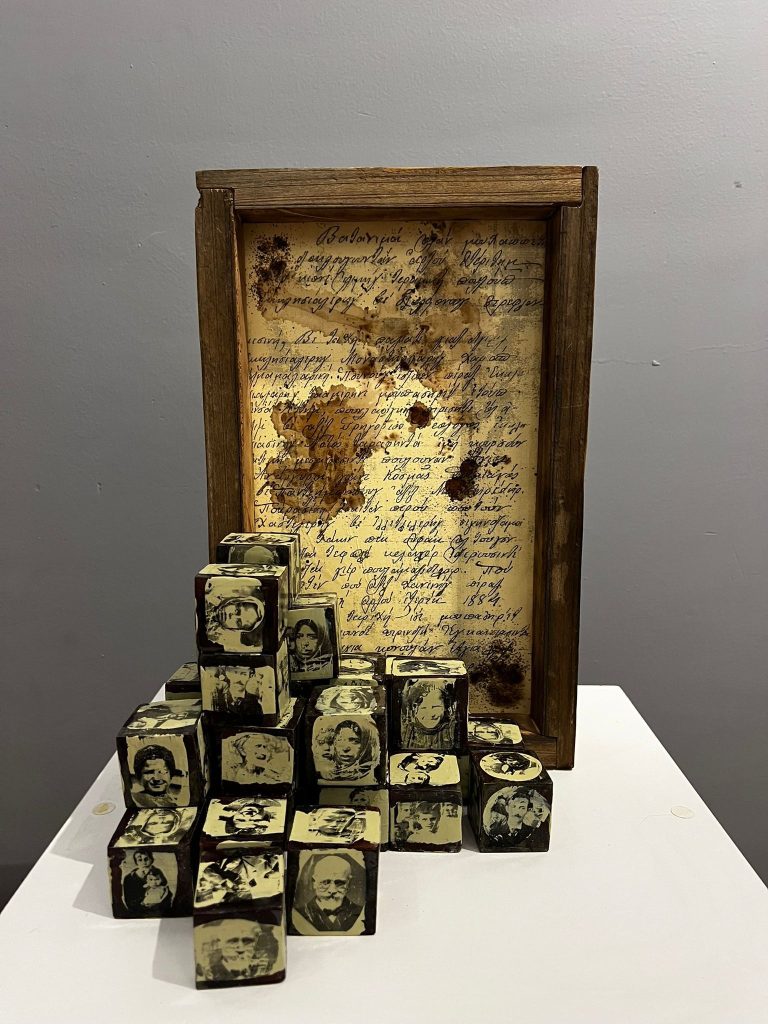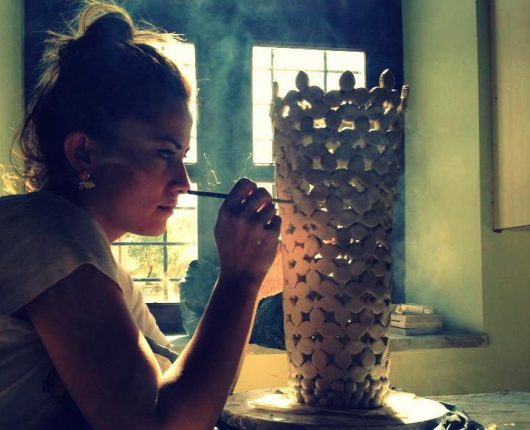GAMZE URAY (Ankara, 1985)
Eskişehir Osmangazi Üniversitesi, Görsel Sanatlar Bölümü
Ötekileştirilenler / The Othered, 2024
Earthenware plastik çamur, elle şekillendirme, artistik sır 1050°C, transfer baskı tekniği, ahşap malzeme, yerleştirme, 41×26 cm, seramik küp 4×4 cm
Earthenware, plastic clay, hand-shaped, artistic glaze fired at 1050°C, transfer printing technique, wooden material, installation, 41×26 cm, ceramic cube 4×4 cm
Mübadele sürecinde daha önce hiç görmedikleri bir coğrafyaya sürgüne zorlanan halk, dil, inanç, gelenek görenek üzerinden çeşitli ithamlara, aşağılanmalara ve psikolojik şiddete maruz kalmıştır. Toplumdan tecrit edilen, dışlanan ve hatta bir korku objesi haline gelen kısaca ötekileştirilen bir halktan bahsedilmektedir. Geldikleri vatanın dilini bilmeyişi, gelenekleri ve sırf geldikleri yerden dolayı hep öteki olmuşlardır. Yeri geldi Türk’ü yeri geldi Yunan’ı, Rum’u hatırlattıkları için yerli halkın gözünde hep yabancı, gâvur olarak görülmüşlerdir. Kısaca ötekileştirilmişlerdir.
“Ötekileştirilenler” adı verilen çalışmada Gelveri’den giden Karamanlı Ortodokslar ve Kavala’dan gelen Türklerin fotoğrafları kullanılarak onların bir araya getirilmesi amaçlanmıştır. Eski bir Rum evinin kapısının kullanıldığı çalışmada mübadilleri aynı çatı altında tutma fikri ağır basmıştır. Ahşap kutunun içinde ise Eforia yani İstanbul’da bulunan Gelveri Okullarını Koruma birliğinden gelen ve mübadele için hazırlık yapmaları gerektiği bilgilerini içeren bir mektup kullanılmıştır. Sergileme için Georgiadou ailesinin evi seçilmiştir. Aslında burada aynı sorunları yaşayan ama birbirinden habersiz olan insanların kavuşması temsil edilmiştir. Kısacası geldikleri yerde de gittikleri yerde de hep ötekileştirilen insanların temsildir.
During the population exchange, people who were forced into exile to a geography they had never seen before were subjected to various accusations, humiliation, and psychological violence through language, faith, and traditions. This was a community marginalized, excluded from society, and even turned into an object of fear—in short, the othered. Their lack of knowledge of the native language of their new homeland, their customs, and simply the fact that they came from “elsewhere” marked them as outsiders. At times they were seen as “the Turk,” at times as “the Greek” or “the Rum,” and thus were always perceived by the local people as foreigners, infidels, strangers. In short, they were othered.
The work titled “The Othered” aims to bring together the photographs of the Karamanlı Orthodox Christians who departed from Gelveri and the Turks who arrived from Kavala. An old Rum (Greek) house door was used in the installation, symbolizing the idea of keeping the exiles under the same roof. Inside a wooden box, a letter from the Eforia—the Union for the Protection of Gelveri Schools in Istanbul—was placed, containing instructions that preparations had to be made for the exchange. The Georgiadou family house was chosen as the exhibition space.
Sanatçı ve eserle ilgili daha fazla bilgi almak için info@base.ist adresine e-posta atmanızı rica ederiz.
Mübadele sürecinde daha önce hiç görmedikleri bir coğrafyaya sürgüne zorlanan halk, dil, inanç, gelenek görenek üzerinden çeşitli ithamlara, aşağılanmalara ve psikolojik şiddete maruz kalmıştır. Toplumdan tecrit edilen, dışlanan ve hatta bir korku objesi haline gelen kısaca ötekileştirilen bir halktan bahsedilmektedir. Geldikleri vatanın dilini bilmeyişi, gelenekleri ve sırf geldikleri yerden dolayı hep öteki olmuşlardır. Yeri geldi Türk’ü yeri geldi Yunan’ı, Rum’u hatırlattıkları için yerli halkın gözünde hep yabancı, gâvur olarak görülmüşlerdir. Kısaca ötekileştirilmişlerdir.
“Ötekileştirilenler” adı verilen çalışmada Gelveri’den giden Karamanlı Ortodokslar ve Kavala’dan gelen Türklerin fotoğrafları kullanılarak onların bir araya getirilmesi amaçlanmıştır. Eski bir Rum evinin kapısının kullanıldığı çalışmada mübadilleri aynı çatı altında tutma fikri ağır basmıştır. Ahşap kutunun içinde ise Eforia yani İstanbul’da bulunan Gelveri Okullarını Koruma birliğinden gelen ve mübadele için hazırlık yapmaları gerektiği bilgilerini içeren bir mektup kullanılmıştır. Sergileme için Georgiadou ailesinin evi seçilmiştir. Aslında burada aynı sorunları yaşayan ama birbirinden habersiz olan insanların kavuşması temsil edilmiştir. Kısacası geldikleri yerde de gittikleri yerde de hep ötekileştirilen insanların temsildir.
During the population exchange, people who were forced into exile to a geography they had never seen before were subjected to various accusations, humiliation, and psychological violence through language, faith, and traditions. This was a community marginalized, excluded from society, and even turned into an object of fear—in short, the othered. Their lack of knowledge of the native language of their new homeland, their customs, and simply the fact that they came from “elsewhere” marked them as outsiders. At times they were seen as “the Turk,” at times as “the Greek” or “the Rum,” and thus were always perceived by the local people as foreigners, infidels, strangers. In short, they were othered.
The work titled “The Othered” aims to bring together the photographs of the Karamanlı Orthodox Christians who departed from Gelveri and the Turks who arrived from Kavala. An old Rum (Greek) house door was used in the installation, symbolizing the idea of keeping the exiles under the same roof. Inside a wooden box, a letter from the Eforia—the Union for the Protection of Gelveri Schools in Istanbul—was placed, containing instructions that preparations had to be made for the exchange. The Georgiadou family house was chosen as the exhibition space.
Sanatçı ve eserle ilgili daha fazla bilgi almak için info@base.ist adresine e-posta atmanızı rica ederiz.

